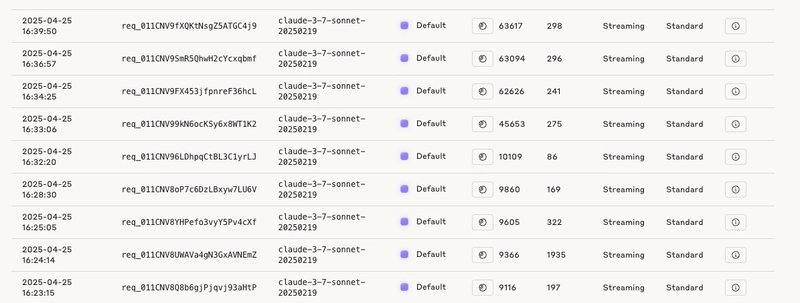Recently, there's been a highly similar, truly open-source project Suna resembling Manus . The developer claims to have completed the development in a small villa in just 3 weeks, and enthusiastically shared a short video using a banana microphone.
The Suna open-source address is: https://github.com/kortix-ai/suna
Blog Introduction: Suna AI: the Open Source General AI Agent
It topped the Github Trending chart on April 25, 2025, making it a must-try.
This project relies on many online services. It took me more than 3 hours to get it running. The result after running is shown in the figure.
After deploying locally, the project defaults to calling the claude-3-7-sonnet-20250219 model, and a task consumes $0.89 worth of tokens.
Currently, recharging $5 to Claude requires an additional $0.33 in tax.
Converted, a news gathering task consumes $0.94 in tokens.
Local Execution / Self-Hosting
Suna can be self-hosted on your own infrastructure. Follow these steps to set up your instance.
1. System Requirements
The following components are required:
- A Supabase project (for database and authentication)
- A Redis database (for caching and session management)
- Daytona Sandbox (for secure proxy execution)
- Python 3.11 (for API backend)
- API keys from an LLM provider (OpenAI or Anthropic)
- (Optional but recommended) Tavily API key (for enhanced search capabilities)
2. Prerequisites
1.Supabase:
- Create a new [Supabase project](https://supabase.com/dashboard/projects)
- Save the project's API URL, anonymous key, and service role key
- Install the [Supabase CLI](https://supabase.com/docs/guides/cli/getting-started)
2.Redis: Set up a Redis instance through the following options:
- [Upstash Redis](https://upstash.com/) (recommended for cloud deployment)
Local installation:
- [Mac](https://formulae.brew.sh/formula/redis): `brew install redis`
- [Linux](https://redis.io/docs/getting-started/installation/install-redis-on-linux/): Follow distribution-specific instructions
- [Windows](https://redis.io/docs/getting-started/installation/install-redis-on-windows/): Use WSL2 or Docker
3.Daytona:
- Create an account at [Daytona](https://app.daytona.io/)
- Generate an API key from the account settings
- Go to [Images](https://app.daytona.io/dashboard/images)
- Click "Add Image"
- Enter `adamcohenhillel/kortix-suna:0.0.20` as the image name
- Set `/usr/bin/supervisord -n -c /etc/supervisor/conf.d/supervisord.conf` as the entry point
4.LLM API Keys:
- Obtain API keys from [OpenAI](https://platform.openai.com/) or [Anthropic](https://www.anthropic.com/)
- While other providers may work via [LiteLLM](https://github.com/BerriAI/litellm), OpenAI and Anthropic are recommended.
5.Search API Key (Optional):
- For enhanced search capabilities, obtain a [Tavily API key](https://tavily.com/)
6.RapidAPI Key (Optional):
- To enable services like LinkedIn, a RapidAPI key is required.
- Each service needs to be activated separately in the RapidAPI account.
7.Accessing Suna:
- Open a browser and visit `http://localhost:3000`
- Register an account using Supabase authentication
- Start using your self-hosted Suna instance!
Suna is revolutionizing the way we access and interact with information. To explore its functionalities firsthand, visit Suna directly. For a comprehensive understanding of Suna's features, use cases, and potential impact, delve deeper into the blog article. It provides an in-depth look at what makes DeepWiki a game-changer in the world of knowledge management.
Summary
The field of AI applications is still in a stage of miracles. Users don't know what they need until developers showcase their products.
At this stage, ordinary users' spending power cannot cover the cost of $1 per task, while enterprise users have strong paying ability. However, they often need to be compatible with legacy systems. Enterprises need to allow large models to replace manual operations and reduce the labor cost of mechanical work and increase the efficiency of the system without transforming the existing systems.










Top comments (8)
Wow, that's a lot of setup steps! Thanks for the breakdown!
dang, love seeing open-source stuff popping off like this - setup took you a minute but still feels worth it to tinker, right? you ever wonder how many open projects just get lost because only a handful of folks can run them without a full weekend free?
Totally agree! It was a bit of a setup hurdle, but still satisfying to get it running. You're right, it's a shame how many promising open-source projects are inaccessible due to complexity.
man the cost for every little thing adds up real quick- i get why people start thinking about self-hosting more. you think the prices for running this stuff ever come down or we just have to get smarter about using it?
Yeah, the costs definitely add up quickly! Self-hosting is looking more appealing, right? I'm hoping prices come down eventually, but in the meantime, smarter usage seems key.
I'm really excited about the potential of a community-driven AI agent.
Great Article!
This looks interesting,